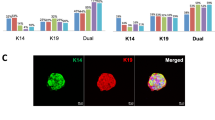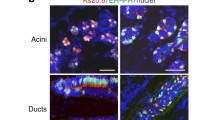Summary
Growth rate, morphology, and responsiveness to mitogenic stimuli and pharmacological treatments were evaluated in early and late cell passages derived from the same clone of the widely used MCF-7 human breast adenocarcinoma cell line. Our results indicate dissimilarities between early (E) and late (L) passages for some of the parameters analyzed. The cells that underwent many subcultivations grew faster than the others; both appeared homogeneous in size and shape. The E cells, subcultured for almost 1 yr, displayed higher sensitivity to the mitogenic action of both estradiol, according to the level of estrogen receptor, and insulin-like growth factor-I than did the L cells, kept in culture for more than 10 yr. Cell responsiveness to two drugs, a novel steroid antiestrogen and a polysulfonated distamycin A derivative, was more pronounced in the early cultures only at the longer time of exposure to the higher concentration of the estrogen antagonist. In addition, a drug-induced inhibition of insulin-like growth factor-I binding to its receptor was shown in both E and L cells, the latter being less sensitive than the former when exposed to the antiestrogen. Finally, MCF-7 E and L cells showed similar behavior when drug-induced apoptosis was tested.
Similar content being viewed by others
References
Arcamone, F. M.; Animati, F.; Barbieri, B.; Configliacchi, E.; D’Alessio, R.; Geroni, C.; Giuliani, F. C.; Lazzari, E.; Menozzi, M.; Mongelli, N.; Penco, S.; Verini, A. Synthesis. DNA-binding properties and antitumor activity of novel distamycin A derivatives. J. Med. Chem. 32:774–778; 1989.
Ciomei, M.; Pastori, W.; Mariani, M.; Sola, F.; Grandi, M.; Mongelli, N. New sulphonated distamycin A derivatives with bFGF complexing activity. Biochem. Pharmacol. 47:295–302; 1994.
Clarke, R.; Thompson, E. W.; Leonessa, F.; Lippman, J.; McGarvey, M.; Frandsen, T. L.; Brunner, N. Hormone resistance, invasiveness and metastatic potential in breast cancer. Breast Cancer Res. Treat. 24:227–239; 1993.
Cross, M.; Dexter, T. M. Growth factors in development, transformation and tumorigenesis. Cell 64:271–289; 1991.
Cullen, K. J.; Yee, D.; Bates, S. E.; Brunner, N.; Clarke, R. E.; Dickson, R. E.; Huff, K. K.; Paik, S.; Rosen, N.; Valverius, E.; Zugmaier, G.; Lippmann, M. E. Regulation of human breast cancer by secreted growth factors. Acta Oncol. 28:835–839; 1989.
de Cupis, A.; Ciomei, M.; Pirani, P.; Ferrera, A.; Ardizzoni, A.; Favoni, R. E. Anti-insulin-like growth factor-I activity of a novel polysulphonated distamycin A derivative in human lung cancer cell lines. Br. J. Pharmacol. 120:537–543; 1997.
de Cupis, A.; Favoni, R. E. Oestrogen/growth factor cross talk in breast carcinoma: a specific target for novel antioestrogen. Trends Pharmacol Sci. 18:245–251; 1997.
de Cupis, A.; Noonan, D.; Pirani, P.; Ferrera, A.; Clerico, L.; Favoni, R. E. Comparison between novel steroidal-like and conventional nonsteroidal antiestrogens in inhibiting oestradiol- and IGF-I induced proliferation of human breast cancer derived cells. Br. J. Pharmacol. 116:2391–2400; 1995.
DeFriend, D. J.; Anderson, E.; Bell, J.; Wilks, J.; West, C. M. L.; Mansel, R. E.; Howell, A. Effects of 4-hydroxytamoxifen and novel pure antioestrogen (ICI 182780) on the clonogenic growth of human breast cancer cells in vitro. Br. J. Cancer 70:204–211; 1994.
DeFriend, D. J.; Howell, A.; Anderson, E.; Nicholson, R. I.; Dowsett, M.; Mansel, R. E.; Blamy, R. W.; Bundred, N. J.; Robertson, J. F.; Saunders, C.; Baum, M.; Walton, P.; Sutcliffe, F.; Wakeling, A. E. Investigation of a new pure antiestrogen (ICI 182780) in women with primary breast cancer. Cancer Res. 54:408–414; 1994.
E.O.R.T.C.—Breast Cancer Cooperative Group. Standards for assessment of estrogen receptors in human breast cancer. Eur. J. Cancer 9:379; 1973.
Favoni, R. E.; Ravera, F.; Pirani, P.; Ardizzoni, A.; Noonan, D.; de Cupis, A.; Suramin interferes with the auto/paracrine insulin-like growth factor-I-controlled proliferative loop on human lung cancer cell lines. Eur. J. Pharmacol. 264:199–206; 1994.
Folkman, J.; Klagsburn, M. Angiogenic factors. Science 235:442–447; 1987.
Gelmann, E. P. Tamoxifen induction of apoptosis in estrogen receptornegative cancers: new tricks for an old dog? J. Natl. Cancer Inst. 88:224–226; 1996.
Heppner, G. H. Tumor heterogeneity. Cancer Res. 44:2259–2265; 1994.
Howell, A.; DeFriend, D.; Robertson, J.; Blamey, R.; Walton, P. Response to specific antiestrogen (ICI 182780) in tamoxifen-resistant breast cancer. Lancet 45:29–30; 1995.
Kang, Y.; Cortina, R.; Perry, R. R. Role of c-myc in tamoxifen-induced apoptosis in estrogen-independent breast cancer cells. J. Natl. Cancer Inst. 88:279–284; 1996.
Lippman, M. E.; Monaco, M. E.; Bolan, G. Effects of estrone, estradiol, and estriol on hormone-responsive human breast cancer in long-term tissue culture. Cancer Res. 37:1901–1907; 1977.
McPerson, G. A. Analysis of radioligand binding experiments: a collection of computer programs for the IBM P.C. J. Pharmacol. Methods 14:213–228; 1985.
Newcomb, P. A.; Lantz, P. M. Recent trends in breast cancer incidence, mortality and mammography. Breast Cancer Res. Treat. 28:97–106; 1993.
Osborne, C. K.; Arteaga, C. L. Autocrine and paracrine growth regulation of breast cancer: clinical implication. Breast Cancer Res. Treat. 15:3–11; 1990.
Parker, M. G. Action of pure antioestrogens in inhibiting estrogen receptor action. Breast Cancer Res. Treat. 26:131–137; 1993.
Ravera, F.; Miglietta, L.; Pirani, P.; Ferrini, S.; Favoni, R. E. Suramin-induced growth inhibition and IGF-I binding blockade on human breast cancer cell lines: potentially related events. Eur. J. Cancer 29A:225–230; 1993.
Reynolds, P.; Boyd, P. T.; Blacklow, R. S.; Jackson, J. S.; Greenberg, R. S.; Austin, D. F.; Chen, U. W.; Edwards, B. K. The relationship between social ties and survival among black and white breast cancer patients. Cancer Epidemiol. Biomark. Prev. 3:253–259; 1994.
Sola, F.; Farao, M.; Pesenti, E.; Marsiglio, A.; Mongelli, N.; Grandi, M. Antitumor activity of FCE 26644, a new growth factor-complexing molecule. Cancer Chemother. Pharmacol. 36:217–222; 1995.
Soule, H. D.; Vazquez, J.; Long, A.; Albert, S.; Brennan, M. A human cell line from a pleural effusion derived from breast carcinoma. J. Natl. Cancer. Inst. 51:1409–1416; 1973.
Stein, C. A.; La Rocca, R. V.; Thomas, R.; McAtee, N.; Meyers, C. E. Suramin: an anticancer drug with a unique mechanism of action. J. Clin. Oncol. 7:499–508; 1989.
Stewart, A. J.; Westley, B. R.; May, F. E. B. Modulation of the proliferative response of breast cancer to growth factor by oestrogens. Br. J. Cancer 66:640–648; 1992.
Strobl, J. S.; Wonderlin, W. F.; Flynn, D. C. Mitogenic signal transduction in human breast cancer cells. Gen. Pharmacol. 26:1643–1649; 1995.
Wakeling, A. E.; Dukes, M.; Bowler, J. A potent specific pure antioestrogen with clinical potential. Cancer Res. 51:3867–3873; 1991.
Wilson, J. W.; Wakeling, A. E.; Morris, I. D.; Hickman, J. A.; Dive, C. MCF-7 human mammary adenocarcinoma cell death in vitro in response to hormone-withdrawal and DNA damage. Int. J. Cancer 61:502–508; 1995.
Zugmaier, G.; Lippman, M. E.; Wellstein, A. Inhibition of pentosan polysulfate (PPS) of heparin-binding growth factors released from tumor cells and blockage by PPS of tumor growth in animals. J. Natl. Cancer. Inst. 84:1716–1724; 1992.
Author information
Authors and Affiliations
Corresponding author
Rights and permissions
About this article
Cite this article
de Cupis, A., Pirani, P., Fazzuoli, L. et al. Responsiveness to hormone, growth factor and drug treatment of a human breast cancer cell line: Comparison between early and late cultures. In Vitro Cell.Dev.Biol.-Animal 34, 836–843 (1998). https://doi.org/10.1007/s11626-998-0039-4
Received:
Accepted:
Issue Date:
DOI: https://doi.org/10.1007/s11626-998-0039-4




